Discover Your Sleep Chronotype: A Guide to Individual Sleep Patterns

Sleep is a fundamental component of health, yet its patterns and requirements can vary widely among individuals.
One key to understanding these differences lies in the concept of “sleep chronotypes,” which describe the natural preferences people have for sleeping and waking at certain times of the day.
Identifying your chronotype can help optimise your daily routines, improve productivity, and enhance overall well-being.
What is a Sleep Chronotype?
A sleep chronotype is a classification that reflects your natural inclination towards certain times for sleeping and waking.
These preferences are influenced by your circadian rhythm, which is your internal biological clock that regulates the sleep-wake cycle and other physiological processes.
Circadian rhythms follow a roughly 24-hour cycle and are influenced by external cues like light and temperature.
Chronotypes can be broadly categorised into several types:
According to the Sleep Foundation, there are four primary chronotypes that describe different sleep-wake patterns: Lion, Bear, Wolf, and Dolphin.
Knowing your chronotype can help you tailor your schedule to fit your natural tendencies, enhancing productivity and quality of life.
Here’s a comprehensive guide to these chronotypes, how to work with them, and how to determine your own.
1. Lion Chronotype
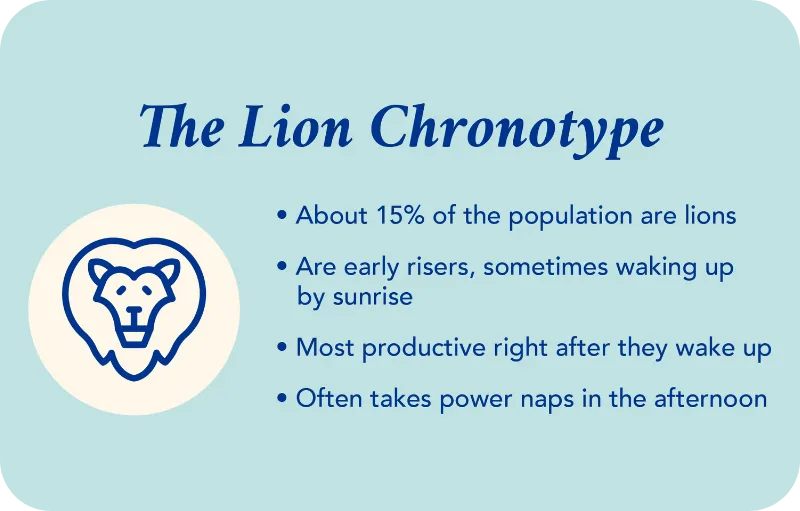
Characteristics: Lions are early risers who feel most energetic and focused in the morning. They typically wake up early and are productive during the first half of the day. Lions tend to go to bed early and value a structured schedule.
Optimal Routine: Lions should plan their most important tasks and activities in the morning when they are at their peak. Maintaining a consistent early bedtime and wake-up time helps them stay aligned with their natural rhythm.
Productivity Tips: Utilise your peak morning hours for complex problem-solving and high-focus work. Lions often excel in environments that require early productivity and disciplined routines.
2. Bear Chronotype
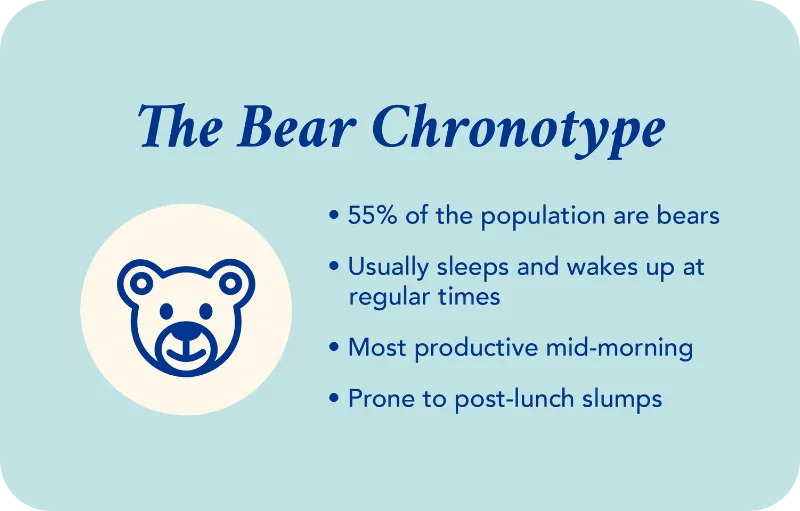
Characteristics: Bears align closely with the natural light-dark cycle. They tend to be most productive during the middle of the day and experience a dip in energy in the late afternoon. Bears typically follow a schedule that reflects the conventional workday.
Optimal Routine: Bears should structure their day around their natural energy peaks, with key tasks scheduled in the late morning to early afternoon. This chronotype benefits from a consistent sleep schedule that aligns with standard work hours.
Productivity Tips: Take advantage of midday productivity surges for important tasks. Bears should also be mindful of their energy dip in the late afternoon and schedule breaks or lighter activities during this time.
3. Wolf Chronotype
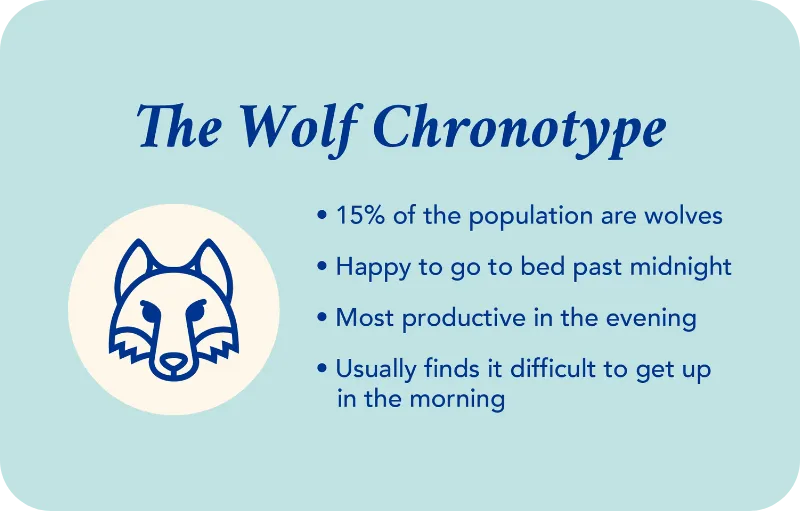
Characteristics: Wolves are naturally inclined to stay up late and wake up later in the day. They are most alert and creative in the evening and often struggle with early morning commitments.
Optimal Routine: Wolves should plan their most demanding tasks and creative work for the late afternoon or evening. It’s beneficial for them to adjust their work or study schedule to fit their natural tendencies.
Productivity Tips: Utilise your peak evening hours for high-focus work and creative tasks. Avoid early morning meetings or deadlines, and create a flexible schedule that accommodates your nocturnal tendencies.
4. Dolphin Chronotype
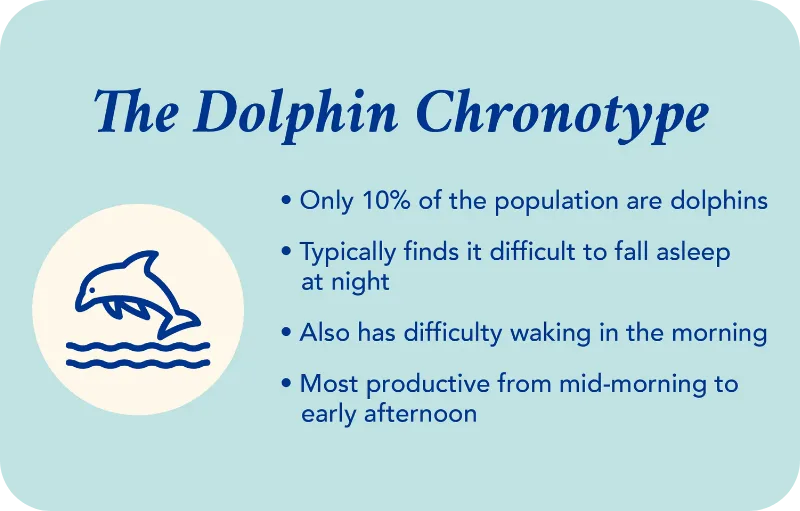
Characteristics: Dolphins are light sleepers who often struggle with insomnia or irregular sleep patterns. They are sensitive to disruptions and tend to be most productive during irregular or unconventional hours.
Optimal Routine: Dolphins should focus on establishing a consistent sleep schedule and managing sleep environment factors that minimise disturbances. Their productivity may vary, so they benefit from a flexible routine that allows for adjustments based on their sleep patterns.
Productivity Tips: Leverage periods of productivity that occur at various times throughout the day. Create a calming bedtime routine to improve sleep quality and consider adjusting your work schedule to accommodate fluctuating energy levels.
How to Determine Your Chronotype
To accurately identify your chronotype, you can take a specialised assessment. The Sleep Foundation provides a chronotype quiz designed to help you understand your natural sleep-wake preferences.
Taking the Chronotype Test
To find out your chronotype, you can complete the chronotype quiz. This test will provide insights into your natural tendencies and help you optimise your daily routine.
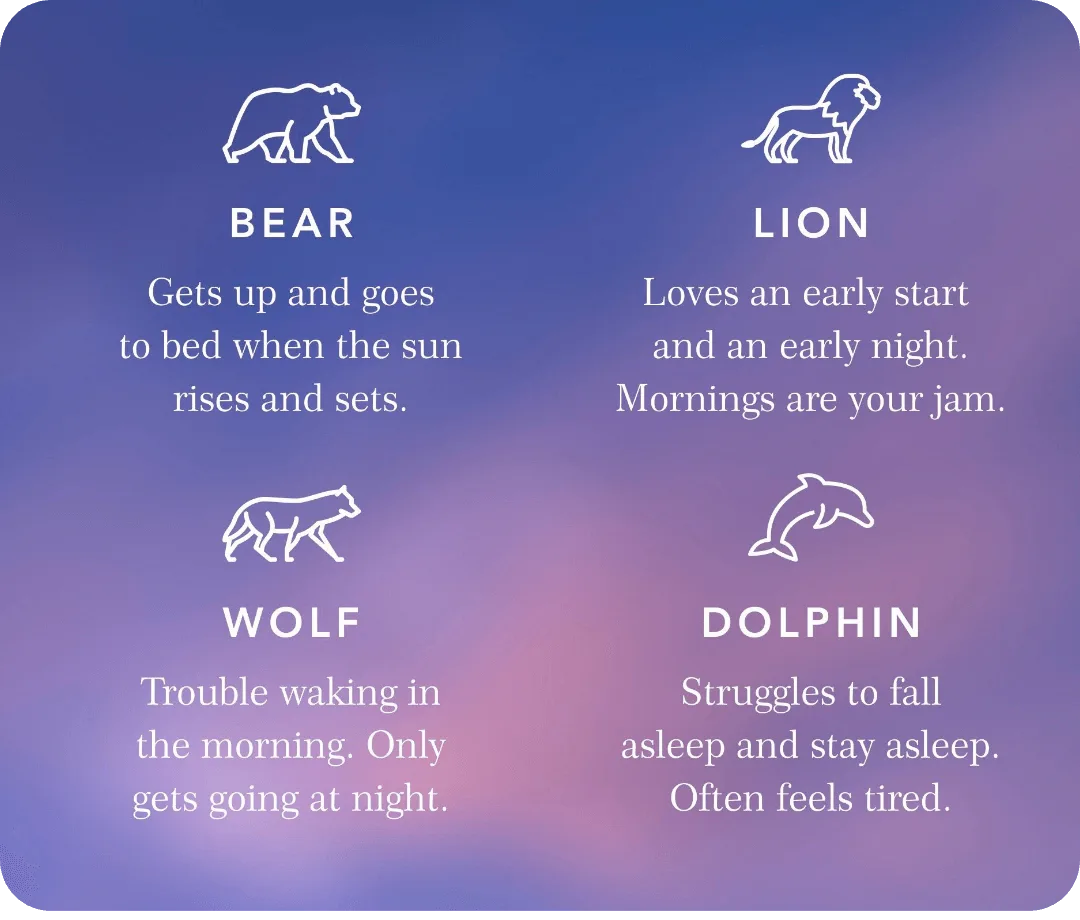
Working with Your Chronotype
Aligning your routine with your chronotype can improve productivity and enhance well-being:
Adjust Your Schedule: Plan your most important tasks according to your chronotype. Early risers (Lions) should focus on morning productivity, while night owls (Wolves) should schedule key activities for the evening.
Create a Sleep-Conducive Environment: Regardless of your chronotype, ensure a restful sleep environment by managing light exposure, maintaining a consistent sleep schedule, and minimizing disturbances.
Adapt to Your Energy Patterns: Tailor your daily activities to your natural energy fluctuations. For instance, Bears should plan around midday energy peaks, while Dolphins should account for their variable productivity times.
Listen to Your Body: Pay attention to your body’s signals and adjust your routine to better fit your natural rhythm, promoting balance and overall efficiency.
Conclusion
By understanding and working with your specific chronotype, you can enhance productivity, improve sleep quality, and achieve a more balanced and fulfilling daily life.



